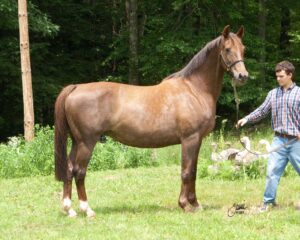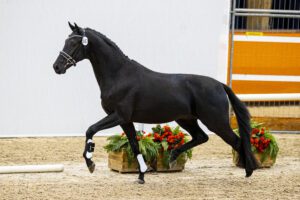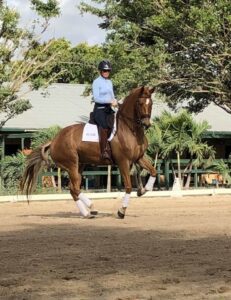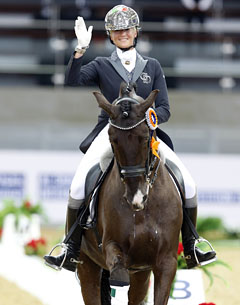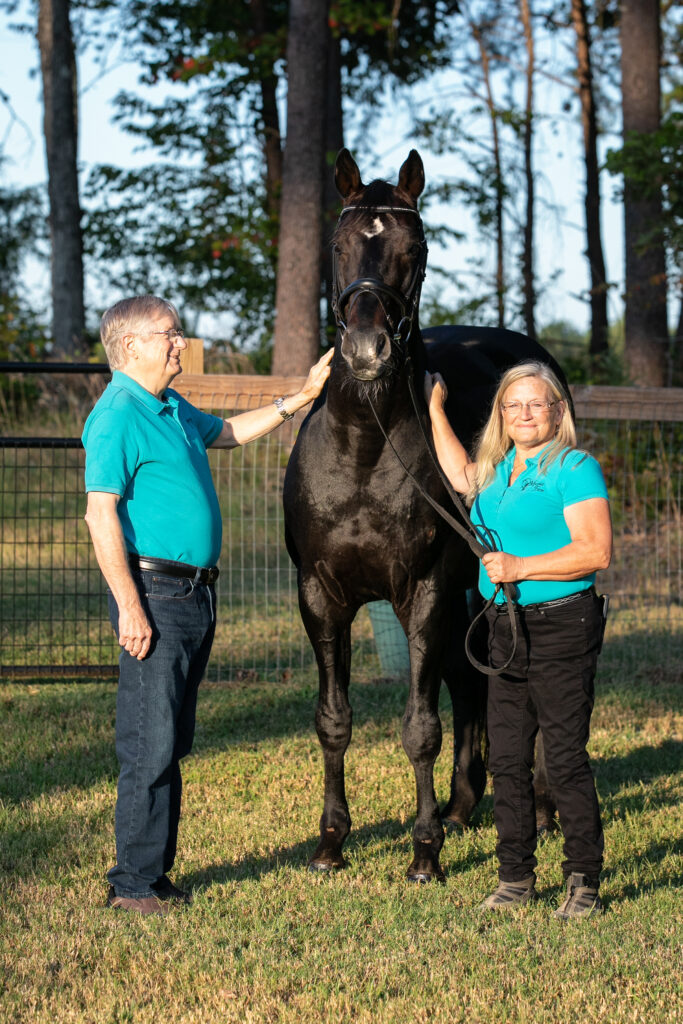Scot Tolman and his family(and Jane Hannigan in the helmet) with Galearites SSF (Totilas x Jazz x Roemer) she was highest IBOP for North American bred horses ever, 85.5
Scot Tolman
Shooting Star Farm http://shootingstarfarm.com
For those of you who don’t know me, I’m Scot Tolman. My family and I have owned and
operated Shooting Star Farm, in Spofford, NH, for over 30 years. Our farm motto is “A place
where dreams come true,” and that’s what we’ve been doing for more than three decades,
making our own dreams and those of our friends and customers become a reality. Our goal is to
produce dressage horses for sport and breeding that are on par with the best in the world. We
were one of the first Platinum-level breeders of KWPN dressage horses in North America. All of
our original breeding stock was imported from the Netherlands, and we maintain a small
program of breeding horses in Nuis, Holland, as well. I have been traveling to the Netherlands
regularly since the late 1990s, usually making two to four trips each year. We are primarily a
breeding operation. Currently, we stand two stallions at Wim Cazemier’s place, in Spencerville,
IN, Gaudi SSF (Totilas x DeNiro x Romancier) and Jaleet SSF (Atleet x Plain’s Liberator x
Manno), and we breed between six and a dozen mares each year. Our foundation mare, Orchis
(Jazz x Roemer), was the highest indexed dressage mare outside of Holland. In Holland, she
would have been one of the top few mares, as well. She is from the top-producing dressage
mareline in KWPN history, the Otrichta stam. Today, in our program, we have three of her
daughters, three of her granddaughters, and three of her nieces. Additionally, we have a mare
from the famous Wendy line, BoWendy (Sir Sinclair x Jazz x Ulft) and a DHH mare from the
very successful DHH line, fok familie 344, Emaldine OMHG (Atleet x Manno x Goya). We have
SSF offspring at every level of dressage sport, from training level to international Grand Prix,
including Mamet SSF (Vitalis x Donatelli x Jazz), who was just named the USDF three-year-old
material Horse of the Year, and Godot SSF (UB-40 x Sir Sinclair x Jazz), who, pre-COVID, was
identified in the talent pool for Team Canada for the Tokyo Olympic games. And, most recently,
Nadal SSF (Just Wimphof x Charmeur x Santano) was selected for the Second Ring in the
KWPN stallion approval process.
A Day in the Life of Scot Tolman:
My average day consists of changing my clothes more often than a runway model and stopping
multiple times per farm task to reply to texts, WhatsApp messages, FB messages, calls, and
emails. There’s a novel called The Diagnosis, by Alan Lightman. By the end of the first chapter,
the protagonist is lying naked on the floor of a subway car in the fetal position clutching his cell
phone. That’s basically me. My contacts in Holland are six hours ahead of EST, and my
contacts on the West Coast are three hours behind. My phone is busy from before I wake up
until after I go to bed. I love it. I love talking horses, and I’m an immediate-gratification kind of
person and border-line ADHD, so I love the constant communication and myriad methods
people have of reaching out. As far as the constant changing of clothes, my wife doesn’t allow
barn clothes in the house, and Muck boots are frowned upon in the gym, so it feels as if every
time I go through a doorway, I have to change my clothes.
Seriously, I have a great life. No complaints. Right now, it’s the slow time of year, so I get up
around 6:30, catch up on correspondence, read the news, do the NYT Mini, then start feeding
things. The wild birds on my deck, our three Frenchies, too many horses, fewer goats than my
wife has rabbits (and, this is a problem–we have a deal that I can’t have more goats than she
has rabbits–I’m at three goats; she’s at five rabbits), and my beloved chickens. Oh, and Carol,
my wife. She cooks one meal a year, Christmas dinner. I do all the rest of the cooking. We have
a fantastic barn guy, Anthony, so he takes over clean out and set up once everyone is fed, and I
move on to answering more messages and errands. I try to find time in the day to write a bit,
whether it’s for our website, magazine articles, or the novel I’m working on. If I go more than a
day or two without getting to the gym, my moods steadily become more grouchy. I try to lift three
to four days a week and do cardio on the off days. Right now, I don’t have a horse to ride, but,
when I do, that adds a few hours to my day. We are currently doing the excavating for our own
indoor, but over the years, I’ve had to drive up to an hour and a half one way to ride. Most
recently, I’ve kept my riding mare at Kathi Bruce’s place in Springfield, VT, so that’s only 45
minutes. Night chores are fast, usually not more than an hour. Then shower, catch up with Carol
and the Frenchies on the couch, Rachel Maddow, maybe an episode of a series if we’re
currently watching one, and then reluctantly put my phone on the charger beside our bed and
crash.
Until breeding and foaling season hits, that’s my day. Since I do all my own breeding work and
foaling, my days and nights revolve around ovulations and milk tests from March through
August–my t-shirts have a perpetual brown/green stain around the right sleeve, and my house
slippers are in some state of saturation or desiccation of placental fluids. As anyone in the horse
business knows, it all goes great…until it doesn’t. A load of hay gets stuck in the driveway, a two
year old insists on ripping down sections of his run-in at least once a week, a baby somehow
ends up with a six-inch gash that needs stitches even though you can’t find ANYTHING in the
perfectly safe and secure paddock that could have inflicted such a wound. Life on a breeding
farm. It’s the best.
What are the Top Three Choices a Breeder Needs to Make:
The number one choice a breeder makes is so important that two and three are almost moot:
Buy the best foundation mare you can possibly afford. I can’t stress this enough. There is
limited long-term success for any breeding program that isn’t built on a really strong mareline
with proven sport results over generations. Breeding from this kind of base automatically
improves your chances of building a successful program for a number of reasons. One,
genetics always come through, eventually. Historically, breeders in Europe pass their marelines
from generation to generation. They have decades of culling, trial and error, and genetic
improvement beyond what almost anyone in North America can boast. A top mare from a top
breeding program gives a new breeding program a proven genetic base. Two, the strong
genetic base allows you to make more mistakes. Matching stallion to mare is an artform that
takes years of research and experience to get right more times than you get it wrong. Strong
foundation mares can produce better than average foals from the less-than-perfect crosses you
are bound to make as a breeder. Three, both for sales and the development of your program,
the higher expense of a top mare will pay for itself over and over again.
Number two is to find a breeding mentor. Although it’s important to do your research, be aware
of the sometimes inane chatter of social media, and take in as much information as you can
process, it’s most important to “listen” to only one or two people whose experiences and
background knowledge match the kind of breeder you want to be. When I first started breeding,
it was in the days before the internet. I used to write letters, make calls, and organize visits with
breeders in Holland. At the time, there were no breeders in North America to emulate. I knew if I
wanted to build the kind of program I had envisioned, I had to find people who could help me.
And, it was, and is, my experience that people who are passionate about their horses and proud
of their programs are more than happy to share their knowledge. When I go to Holland, I feel
welcomed, at home, and appreciated. Breeders are valued more in Europe than they are in
North America. It is a point of both pride and concern for me that our program and its
accomplishments get much more published recognition in Holland than they do in the USA.
And, it’s not just our program; it’s almost all breeding programs in North America. This has
changed some due to the advent of the internet, but, until the last few years, the only breeding
programs that received much recognition were the ones with huge advertising budgets.
OK. That turned into a rant. Sorry! Number two: Find a mentor. No need to reinvent the wheel
at every step in the development of your program.
And, number three, have a vision. All successful companies or enterprises start with a vision
statement. Breeding horses is no different. A vision statement can be adjusted over
time–probably should be adjusted–but if you don’t know the end goal, it’s really difficult to
create the steps of the staircase that will take you there. Mine was” To breed the kind of horse I
wanted to ride but couldn’t afford to buy. It’s morphed into what I wrote above, “to produce
dressage horses for sport and breeding that are on par with the best in the world.” Again, our
farm motto is “A place where dreams come true.” Both are lofty, yes. Idealistic, yes. But, that’s
what a vision statement should be. Something to shoot for and something to guide you along
the way.
What is the role of the breeder in producing top sport horses?
Any time I’m asked this question, or something similar, I go back to a conversation I had with
Wiepke Van de Lageweg, founder of VDL stud, many years ago. He said, “It’s the breeders job
to lead the KWPN, not the KWPN’s job to lead the breeder. I have always followed this advice. It
is the breeder’s job to evaluate sport results and breeding trends, then make decisions that
advance the quality of horse necessary for the job. This guides many of my decisions. Totilas
was a game changer for me. Never had I seen a horse with such adjustability and balance.
Balance and athleticism are my goals, and my job, as a breeder. I breed for horses that have
the natural ability to carry themselves. My job as a breeder is to produce a horse that is naturally physically capable of the work demands at the highest level of sport. When I attend keurings or
inspections, or watch the young stallions du jour online, I often see an inordinate focus on the
trot. Any knowledgeable dressage enthusiast will tell you that a trot can be created; a horse has
to be born with a good canter and walk to be successful at the upper levels. My job, as a
breeder, is to focus on the qualities necessary for the very top level of sport, regardless of the
direction in which my studbook or popular opinion is currently promoting.
Top five attributes I look for in a mare I would want to use in my program.
I think I’ve covered the most important part of this answer already: Start with a mare from a
proven sport line. But, if I you’re asking me to break it down into five attributes, I’ll give it a shot:
1. The mare is from a proven sport line.
2. The mare herself has a type consistent with the mareline
3. The mare herself is athletic and balanced
4. The mare herself has a workable temperament
5. I have to have her.
Did COVID affect your business?
To my great surprise, no. Gaudi bred 160 mares. We sold out of horses. We’ve sold all but one
of our 2021 babies. And, we’ve sold almost all of our 2022 babies. COVID has been very good
to us.
Tell us one of your mentors in the equestrian world:
I’ve alluded to this already in my response to an earlier question. Mentors have been key in my growth and success as a breeder. My first mentor was Gert Van der Veen, Head Inspector of
the KWPN many years ago. He has long since left us, but, for a man with as much knowledge
and experience, he was incredibly approachable and willing to share his vast knowledge. I owe
him a huge debt of gratitude. One of my most cherished moments is when, after years of my
pestering him with questions and advice, he called me out of the blue just to talk horses. My
other mentor, now valued friend, is Gerard Vervoorn, current protector and maestro of the
Otrichta stam. There is no one whom I trust more for breeding conversation than Gerard.
What would be helpful for breeders in the USA to promote their breeding programs?
This is an easy answer: Recognition. At any competition, inspection, or publication in Europe,
no matter how small or how large, the breeder is recognized for every horse. In North America,
we’re lucky if the rider and owner know the horse’s sire, let alone the breeder. This is a huge
problem. It’s a huge slap in the face to North American breeders. Why do Helgstrand,
Schockemohle, Van Olst, Van Uytert, VDL, and other top stallion and sales operations contract
with many European breeders to have first option on their foals? Because they know who is
consistently producing the top horses. In Europe, breeders are seen as a vital cog in the
machinery that produces the top equine athletes. Here, for many people, we don’t exist. My
response may seem histrionic, but ask yourself if you’ve ever been at a competition in North
America where more than the rider and owner were listed or announced with the name of the
horse. Have you ever read a national publication, other than the direct publications of the
studbooks themselves, that lists the name of the breeder in an article? It makes me crazy. So, yes, there is something that would be helpful for breeders in the USA to promote their breeding
programs, a system that recognizes them and what they do.
What do you do on your days off?
The only way I really get a day off is to get out of town! Even then, the horses are always on my
mind. Carol and I try to do one big vacation in February each year. Last year, we spent an
amazing two weeks in Tanzania on safari, then flew to Rwanda to see the Mountain Gorillas. It
was amazing. Carol loves to travel. I tolerate it, but, once I’m there, invariably I enjoy myself. We
have a two-year-old granddaughter and another granddaughter on the way, so I’m sure there
will be many family adventures in the future. But, honestly, my favorite vacations are horse
vacations. I travel to Holland a few times a year. Those trips are always highlights for me,
especially the KWPN Stallion Show.
Orchis (Jazz x Roemer x Eros) bred by Gerard Vervoorn, Shooting Star Farm foundation mare
Nadal SSF (Just Wimphof x Charmeur x Santano) recently selected for the KWPN second ring
Godot SSF (UB-40 x Sir Sinclair x Jazz) with Eiren Crawford. Grand Prix Dressage horse sold to Carolin Mallmann.
Scot Tolman can be reached at Tolmanc@gmail.com or 603-209-3243. More information on KWPN horses can be found here http://www.kwpn.org
Thank you Scot for giving https://horses4yc.com such an informative article on breeding. I hope to have you back for more!!! #H4YC #warmbloods #FEI #letsdothis #dressage #equestrianlife

